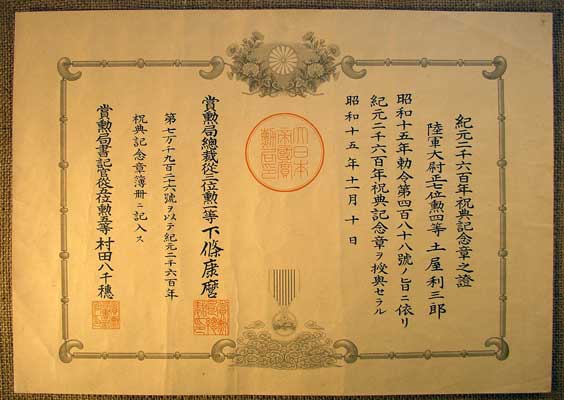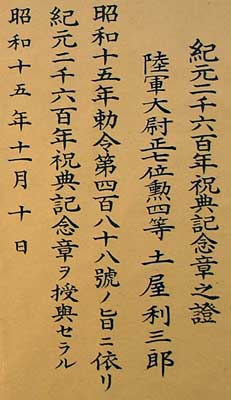Nambu World: 2600th
Anniversary Commemorative Medal

This
medal was awarded to commemorate the 2600th anniversary of Emperor
Jimmu establishing the Japanese Empire, a semi-mythological event said to have
taken place in 660BC. This event was used in
Here is the back of the medal. It has the usual style of clasp on the ribbon.

In this close-up of the front you
can see a chrysanthemum, the symbol of the Imperial family, at the top. The
bridge is a famous tourist scene that is on countless postcards. It is called Nijubashi
and is the bridge that leads into the

This close-up of the back has the
vertical inscription ki-gen-ni-sen-rop-pyaku-nen-shuku-ten-ki-nen-sho,
or “2600th year of the Imperial Era Celebration Commemorative Medal”.
The text along the bottom edge reads from right to left: sho-wa-ju-go-nen, or Showa 15 (1940).

Here is the case, which is made of textured
cardboard. The characters in the vertical column are the same as on the back of
the medal (transliterated and translated immediately above). The box is 111mm X
61mm X 19mm (4-5/16” X 2-3/8” X 11/16”).

Here is the medal safely nestled in its case.

The certificate is 419mm X 297mm
(16-1/2” X 11-11/16”). It has a watermark in the upper right corner (nothing in
the lower left). There is nothing printed or stamped on the back, but someone
has handwritten in pencil the katakana yu
and the number 38 in the upper right corner of the back.

The right side has the key information, including the recipient’s name and the date. I have four certificates that were issued to this same recipient, Risaburo Tsuchiya (surname Tsuchiya; the others can be seen in the sections on the Late WWI medal, Manchurian Incident Medal and China Incident Medal).
Here is a transliteration of the Japanese:
First column on far right: ki-gen-ni-sen-rop-pyaku-nen-shuku-ten-ki-nen-sho-no-sho
Second column from right: riku-gun-tai-i-sho-nana-i-kun-yon-to-tsuchi-ya-ri-sabu-ro
Third column from right: sho-wa-ju-go-nen-choku-rei-dai-yon-byaku-hachi-ju-hachi-go-o-mune-ni-yo-ri
Fourth column from right: ki-gen-ni-sen-rop-pyaku-nen-shuku-ten-ki-nen-sho-o-ju-yo-seraru
Last column on left: sho-wa-ju-go-nen-ju-ichi-gatsu-to-ka
My rough translation is: “Certificate for 2600th Year of the Imperial Era Celebration Commemorative Medal. Army Captain Risaburo Tsuchiya, Seventh Rank, Holder of the Fourth Order of Merit, is awarded this 2600th Year of the Imperial Era Celebration Commemorative Medal in accordance with Imperial Decree number 488 of Showa 15 [1940]. Dated this 10th day of November, Showa 15 [1940].

There left side has the formalities from the Board of Decorations.
Here is a transliteration of the Japanese text:
First column on far right: sho-kun-kyoku-so-sai-ju-san-i-kun-it-to-shimo-jo-yasu-maro
Second column on right: dai-nana-man-sen-kyu-hyaku-ni-ju-roku-go-o-mot-te-ki-gen-ni-sen-rop-pyaku-nen
Third column on right: shuku-ten-ki-nen-sho-bo-satsu-ni-ki-nyu-su
Last column on left: sho-kun-kyoku-sho-ki-kan-ju-go-i-kun-go-to-mura-ta-ya-chi-o
My rough translation is: “President of the Board of Decorations Yasumaro Shimojo, Junior Third Rank, Holder of the First Order of Merit. We have recorded this [certificate] as number 71926 in the Register of 2600th Year of the Imperial Era Celebration Commemorative Medals. Secretary of the Board of Decorations Yachio Murata, Junior Fifth Rank, Holder of the Fifth Order of Merit.” The translations of honours of the officials are somewhat tentative; I have followed the example of a translation on pages 20-21 of OMJAS, but I do not have great confidence that they got it right, either. I have yet to see a good, clear explanation of this system of honours and its relationship, if any, to the medals awarded as Orders of Merit.

Here is the artwork at the top-middle of the certificate, with the Imperial chrysanthemum in the centre.

The round red seal below it says dai-nip-pon-tei-koku-sho-kun-kyoku-in, or “Seal of the Board of Decorations of the Empire of Greater Japan”.

Here is the artwork at the bottom centre of the certificate.

The watermark in the upper right is again the Imperial chrysanthemum. The photo appears very orange because I had to put an incandescent light right behind the certificate to get the watermark to show up in a photo.

To return to the primary page on
Medals, please click here: Nambu
World: Japanese Medals
To return to “Other Japanese
Militaria”, please click here: Nambu
World: Other Japanese Militaria
To return to the home page, please
click here: Nambu World: Teri’s WWII Japanese
Handgun Website
Last updated: August 5, 2006. All contents are copyright Teri
unless otherwise specified and may not be used elsewhere in any form without
prior permission.